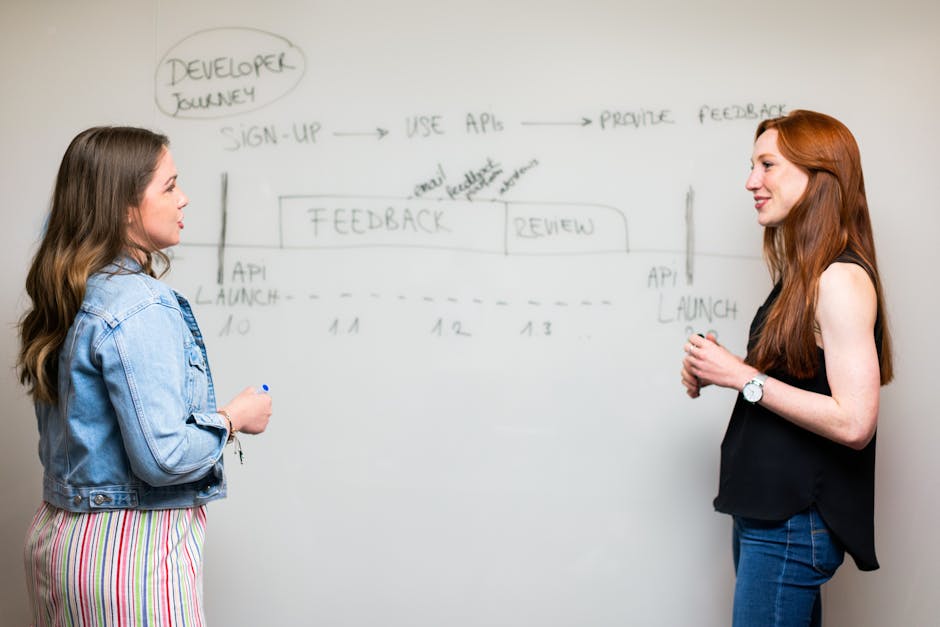Software Developers Offering Sweat Equity Deals: What To Look For
Savvy software seekers searching for the perfect developer partnership may find themselves considering sweat equity deals. With these arrangements, a software developer contributes their skills and expertise to your innovative project in exchange for a stake in the company or future profits rather than upfront payment. This can be an attractive option for start-ups looking to preserve precious capital while attracting top talent, but it’s crucial to know what to look out for when entering into such agreements.
You don’t want your desire for innovation clouding your judgement, so it’s essential to approach sweat equity arrangements with a detail-oriented and analytical mindset. As you evaluate potential developer partners, it’s important to focus on determining fair compensation, establishing clear expectations, protecting intellectual property rights, and navigating legal considerations.
In this article, we’ll delve into each of these factors and provide expert insights on how to ensure a successful and mutually beneficial partnership with your chosen software developer.
Determining Fair Compensation

Now comes the tricky part: figuring out what’s fair compensation for your hard work and dedication!
It’s crucial to conduct a thorough fairness assessment before diving into any sweat equity deals. This involves researching market rates for similar roles and skill sets in your industry, evaluating the potential value of the company or project you’ll be working on, and considering factors such as benefits, flexibility, and company culture.
Keep in mind that while it may be tempting to agree to an initially lower salary in exchange for equity, you should still ensure that your base compensation is sufficient to cover your living expenses and maintain financial stability.
During the compensation negotiation process, it’s important to communicate openly with the other party about your expectations and concerns. Be prepared to justify your desired compensation package by highlighting your unique skills, experiences, and contributions that will add significant value to their business.
Remember that this is not just about securing a paycheque; it’s also about finding a partnership where both parties can grow together through innovation and collaboration. Furthermore, don’t be afraid to ask questions or request clarifications during negotiations; this demonstrates your commitment to finding a mutually beneficial agreement.
As you finalise the terms of your sweat equity deal, make sure all aspects of the agreement are clearly defined – from the percentage of ownership being offered down to specific milestones or deliverables tied directly to equity rewards. This helps reduce ambiguity around performance expectations for both parties moving forward.
With everything set in place regarding fair compensation tailored specifically for software developers like yourself who are offering sweat equity deals, it becomes essential now more than ever before for both parties involved in these agreements – developer(s) & business owner(s), alike – establish clear expectations right from get-go so no one winds up feeling shortchanged later down road when success starts rolling-in full force!
Establishing Clear Expectations

Setting sky-high expectations is crucial when diving into a business partnership that involves trading hard work for a slice of the company’s potential success. One of the most common expectation pitfalls in sweat equity deals with software developers is assuming all parties have the same vision for the project, without explicitly discussing and documenting it. To avoid this issue, ensure that you communicate openly and consistently about your goals, objectives, and desired outcomes with your developer partner.
Communication importance should not be underestimated; it can make or break your partnership. When establishing clear expectations in sweat equity deals, take time to define roles and responsibilities for each party involved. This includes outlining tasks to be completed by both you and the developer within specific timeframes. It’s also essential to establish milestones for project progress, so you can measure whether things are on track or if any adjustments need to be made along the way.
By having these details in place before starting work together, both parties will feel more confident moving forward with their respective contributions to the project. As you continue refining your expectations and fostering open communication channels with your software developer partner, also consider addressing potential future changes or challenges that may arise during the course of your collaboration.
Preparing contingency plans for unexpected scenarios will help reduce friction between partners as they navigate uncharted territory together. Additionally, keeping an open mind about adapting your initial plans can lead to innovative solutions that enhance overall project success. With expectations firmly established and communication lines wide open at every stage of development, you’ll pave a smoother path toward realising shared goals – one where intellectual property protection becomes another essential component of navigating this exciting journey together.
Intellectual Property Protection

It’s vital to not overlook the importance of intellectual property protection when engaging in a sweat equity partnership, as it can significantly impact the success of your collaboration. Ensuring that both parties have a clear understanding of IP ownership transfer and infringement risks will prevent potential disputes down the line.
This includes having clearly defined terms on how any newly developed software or enhancements to existing products will be owned, licenced, and protected. When dealing with intellectual property issues, you should take into account various aspects such as copyrights, trademarks, patents, and trade secrets.
It’s essential to establish solid agreements regarding these matters from the outset; this may involve seeking legal counsel to draught appropriate contracts that protect all parties’ interests. Additionally, consider implementing non-disclosure agreements (NDAs) to safeguard confidential information shared between partners during the development process.
By taking these precautions upfront, you minimise potential infringement risks and pave the way for a more secure partnership. As you move forward with your sweat equity deal, remember that protecting your intellectual property is just one aspect of ensuring a successful collaboration.
Equally important is evaluating potential developer partners based on their technical expertise, communication skills, and alinement with your project goals. By carefully considering each of these factors before entering into an agreement, you’ll increase your chances of forming a mutually beneficial partnership that fosters innovation and growth for all parties involved.
In turn, this sets the stage for our next discussion on how best to evaluate potential developer partners for your venture.
Evaluating Potential Developer Partners

Diligently delving into the details of potential developer partners during your quest for a fruitful sweat equity collaboration is crucial to cultivating a strong, successful alliance. Developer vetting plays a pivotal role in this process as it helps you identify individuals or teams with the necessary skills, experience, and work ethics that aline with your project goals. By being thorough in your evaluation, you can avoid partnership pitfalls and build a team capable of bringing your innovative ideas to life.
To effectively assess potential developer partners, consider focussing on these three key areas:
- Technical expertise: Evaluate their proficiency in the programing languages, frameworks, and tools required for your project.
- Portfolio: Analyse their past projects to gauge their ability to deliver high-quality work within deadlines.
- Communication skills: Ensure they possess strong communication abilities that foster seamless collaboration and efficient problem-solving.
As you continue refining your shortlist of potential developer partners, it is essential to also consider how well they mesh with your company culture and vision. Assessing cultural fit goes beyond technical acumen; it evaluates whether candidates are adaptable enough to embrace change while maintaining an unwavering commitment to innovation.
Bear in mind that sweat equity partnerships require immense trust between all parties involved – after all, you’re investing significant time and resources into each other’s success.
Navigating through the complexities of evaluating potential developer partners may seem daunting at first but doing so will ensure that you forge lasting relationships built upon mutual respect and shared aspirations. Once you have selected the right partner(s), it becomes imperative to address legal considerations in sweat equity agreements – an important step towards safeguarding both parties’ interests throughout the collaboration process.
Legal Considerations in Sweat Equity Agreements

Navigating the legal aspects of sweat equity agreements can be a minefield, but it’s essential to protect both you and your developer partner from potential pitfalls down the road. Thorough contract negotiations not only safeguard your interests but also foster trust between parties. Before diving into creating a sweat equity agreement, you need to understand some fundamental legal considerations.
| Key Considerations | Description |
|---|---|
| Ownership structure | Determine how ownership will be divided amongst founders, including voting rights and decision-making authority. It’s crucial to have this in writing as it prevents misunderstandings and conflicts later on. |
| Vesting schedule | Establish a vesting schedule that determines when your developer partner earns their share of equity over time. This helps ensure they remain committed to the project long-term while protecting your interests should they leave unexpectedly. |
| Dispute resolution | Include provisions outlining how disagreements or disputes will be resolved to minimise conflict escalation and potentially costly litigation. Options could include mediation or arbitration services before proceeding with any court action if necessary. |
As you move forward with crafting a legally-sound sweat equity agreement for your software development venture, keep these key considerations in mind while working closely with an attorney experienced in start-up law or intellectual property law for guidance tailored specifically to your situation – after all, prevention is better than cure! Engaging in open communication with your developer partner throughout the process will help ensure that everyone is on the same page regarding expectations, responsibilities, and each party’s contributions towards making this innovative collaboration successful for years to come!
Frequently Asked Questions
What are the potential tax implications of a sweat equity deal for both the developer and the company?
When exploring tax strategies and legal considerations for sweat equity deals, you should be aware of the potential tax implications for both you as a developer and the company.
Typically, sweat equity is taxed when the recipient sells their shares or when they’re granted, depending on the type of agreement in place. To minimise tax liabilities, it’s crucial to structure your deal thoughtfully by considering different types of equity grants like restricted stock units (RSUs), incentive stock options (ISOs), or non-qualified stock options (NSOs).
Additionally, keep in mind that some arrangements may require adherence to specific rules under Internal Revenue Code Section 409A. By staying informed about these complexities, you can better position yourself for innovative growth opportunities while remaining compliant with tax regulations.
How can a company determine if a sweat equity arrangement is more beneficial than traditional payment methods for software development?
Did you know that 80% of start-ups fail within the first 18 months? To improve your odds and stay ahead of the curve, it’s crucial to consider alternative compensation methods like sweat equity pros.
Sweat equity arrangements can be more beneficial than traditional payment methods for software development in several ways. Firstly, they allow your company to save on upfront costs while still attracting top-tier talent – developers who are passionate about their work and dedicated to seeing the project succeed. Additionally, by offering a stake in the company’s future success, you create a sense of ownership and encourage long-term commitment from your team members, which ultimately leads to better product quality.
To determine if sweat equity is right for your business, weigh the potential benefits against any drawbacks or risks associated with this non-traditional approach – keeping in mind that innovation often requires taking calculated chances.
What steps should be taken to maintain a healthy working relationship between the company and the developer during the sweat equity agreement?
To maintain a healthy working relationship during a sweat equity agreement, it’s crucial to focus on maintaining transparency and setting expectations from the get-go.
Openly discuss project goals, timelines, and each party’s responsibilities to ensure everyone is on the same page.
Establish clear communication channels and provide regular updates about progress or any roadblocks that may arise.
Encourage innovation by fostering an environment where new ideas are welcomed and explored together as a team.
By tackling challenges head-on and being transparent throughout the process, you’ll strengthen your collaborative partnership, ultimately leading to a successful outcome for both parties involved in the sweat equity arrangement.
How can the success of the sweat equity deal be measured and evaluated over time to ensure it is meeting the desired objectives for both parties?
Imagine walking a tightrope while juggling your developer expectations and equity evaluation; it’s quite the balancing act! To ensure the success of your sweat equity deal, you need to establish a set of well-defined performance indicators that aline with both parties’ desired objectives.
These metrics could include project milestones, code quality, product adoption rates, or even customer satisfaction scores. Regularly review these indicators together with your developer to identify areas where improvements can be made and celebrate achievements.
Adopting an open communication style and fostering a culture of innovation will enable you both to adapt effectively to changes in requirements, technology trends, or market conditions along the way. By diligently tracking progress against agreed-upon objectives and maintaining transparency throughout the process, you’ll create a win-win situation for everyone involved in this innovative partnership.
Are there any specific industries or types of projects where sweat equity deals for software development are more common or particularly successful?
When considering sweat equity trends and project selection, it’s essential to recognise that certain industries and types of projects have a higher success rate. Generally, start-ups in the tech sector, particularly those focussing on innovative solutions like artificial intelligence, blockchain technology, and fintech, are more likely to benefit from software development sweat equity deals.
This is because these industries often require cutting-edge expertise that can be expensive to acquire through traditional means. Furthermore, these sectors tend to have rapid growth potential and scalability, which can lead to substantial returns for both parties involved in the sweat equity agreement.
So if you’re eying opportunities in these areas or seeking projects with a strong focus on innovation and potential for disruption, you’re more likely to find success with sweat equity arrangements.
Conclusion
In conclusion, don’t leave your hard work up in the air like a delicate house of cards. Approach sweat equity deals with caution and diligence.
Make sure you’ve established fair compensation, clear expectations, intellectual property protection, and evaluated potential developer partners before diving headfirst into such agreements.
Remember that legal considerations are the glue holding these deals together. Being analytical and detail-oriented will ensure a sturdy foundation for your software development endeavours with sweat equity partnerships.
Contact us to discuss our services now!
